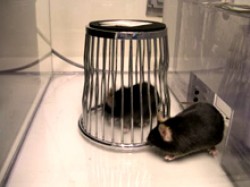Compound Points to Potential Autism Therapy
Compound Points to Potential Autism Therapy
An experimental compound reversed certain autism-like behaviors in mice. The finding may lead to a new strategy for treating autism spectrum disorders (ASD).

A mouse pays a social visit to a novel animal. Image courtesy of Drs. MuYang and Jacqueline Crawley, NIMH Laboratory of Behavioral Neuroscience.
ASD includes several related brain disorders with symptoms ranging from mild to severe. People with ASD generally have trouble with social interactions and repetitive behaviors. There’s no proven cure, but treating ASD early with specific behavioral interventions can reduce symptoms.
Past studies have linked the brain’s glutamate neurotransmitter system to ASD. Glutamate is used by nerve cells in the brain to communicate. It also plays an important role in wiring up the brain during early development.
Drugs that target a glutamate receptor called mGluR5 are now in clinical trials for fragile X syndrome, the most common form of inherited intellectual and developmental disabilities. About 30% of patients with fragile X syndrome meet the diagnostic criteria for autism. A research team led by Dr. Jacqueline Crawley of NIH’s National Institute of Mental Health (NIMH) reasoned that the mGluR5 receptor might be a potential target for ASD therapies.
To test their hunch, the scientists examined the effects of an mGluR5 inhibitor in a naturally occurring inbred strain of mice, called BTBR, that displays autism-like behaviors. Like children with ASD, BTBR mice interact and communicate relatively less with each other and engage in repetitive behaviors, such as spending an inordinate amount of time grooming. The mGluR5 inhibitor, called GRN-529, was developed by Pfizer, whose scientists also participated in the study. Results appeared on April 25, 2012, in Science Translational Medicine.
The researchers found that BTBR mice injected with GRN-529 showed reduced levels of repetitive self-grooming. They also spent more time around—and sniffing nose-to-nose with—a novel mouse. Similar doses of GRN-529 almost completely stopped the repetitive jumping that characterizes another strain of mice called C58/J.
“Our findings suggest a strategy for developing a single treatment that could target multiple diagnostic symptoms,” Crawley says.
Genomic studies suggest that many cases of autism are caused by mutations in genes that control the formation and maturation of synapses, the connections between neurons. “Since defects in these connections are not immutably hard-wired,” Crawley says, “the core symptoms of autism may be treatable with medications.”
###
* The above story is reprinted from materials provided by National Institutes of Health (NIH)
** The National Institutes of Health (NIH) , a part of the U.S. Department of Health and Human Services, is the nation’s medical research agency—making important discoveries that improve health and save lives. The National Institutes of Health is made up of 27 different components called Institutes and Centers. Each has its own specific research agenda. All but three of these components receive their funding directly from Congress, and administrate their own budgets.




















